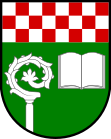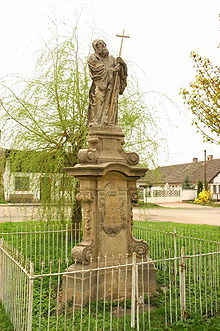Hořiněves
| Hořiněves | ||||
|---|---|---|---|---|
|
||||
| Basic data | ||||
| State : |
|
|||
| Region : | Královéhradecký kraj | |||
| District : | Hradec Králové | |||
| Area : | 1266 ha | |||
| Geographic location : | 50 ° 19 ' N , 15 ° 46' E | |||
| Height: | 267 m nm | |||
| Residents : | 693 (Jan. 1, 2019) | |||
| Postal code : | 503 03 - 503 06 | |||
| License plate : | H | |||
| traffic | ||||
| Street: | Velký Vřešťov - Chlum | |||
| structure | ||||
| Status: | local community | |||
| Districts: | 4th | |||
| administration | ||||
| Mayor : | Jana Kuthanová (as of 2008) | |||
| Address: | Hořiněves 73 503 06 Hořiněves |
|||
| Municipality number: | 570044 | |||
| Website : | www.horineves.cz | |||
Hořiněves (German Horschenowes , also Horzeniowes or Hořeniowes , 1939-1945: Brenndorf ) is a municipality in the Czech Republic . It is located seven kilometers west of Smiřice and belongs to the Okres Hradec Králové .
geography
Hořiněves is located in the southern foothills of the Horschitzer Uplands on a ridge between the Trotina and Bystřice valleys . To the southeast rises the Rejdiště hill (317 m), which is also called Tumplac. In the southwest lies the Svíb ( Swiep , 330 m). The Hněvčeves – Smiřice railway line runs north of the village .
Neighboring towns are Vrchovnice and Jeřičky in the north, Lužany and Frantov in the north-east, Račice nad Trotinou in the east, Sendražice in the south-east, Neděliště and Máslojedy in the south, Čistěves in the south-west, Benátky in the west and Třebovětice and Cwestřicí nad Bwystřicí in the north.
history
The first written mention of the village and the fortress Hořiněves took place in 1238, when Zbraslav von Hořiněves, the cupbearer Wenceslas I , had the property attributed to his wife. In 1279 Mutina Vřešťovský von Hořiněves struck a division of the Brandenburgers in the area, who wandered around looting. In 1425 - apparently during internal disputes, as the owner of the estate Prokop von Hořiněves himself was a supporter of the Hussites - Hussites conquered the fortress.
In 1612 the rule was so over-indebted that the Lords of Hořiněves had to sell the property to Jan Purkart Kordul von Sloupno. Its property was confiscated in 1623 for participating in the class uprising. The following year, Albrecht von Waldstein bought the Hořiněves rule and in 1625 passed it on to Marie Magdalena Trčka from Lípa on Smiřice , who connected the two dominions. After the night of Eger's murder, in which in 1634 his brother-in-law Adam Erdmann Trčka von Lípa was killed together with Waldstein , Trčka's goods were confiscated and sold to Matthias Gallas in 1636 . During the Thirty Years War, the Swedes invaded in 1645 and burned the fortress down. In 1661 the lordship Hořiněves, which included Hořiněves 21 other villages, was separated from Smiřice again. His son Franz Ferdinand von Gallas sold the rule, which had meanwhile grown to a total of 27 villages, to Johann von Sporck in 1674 . Under Johann Karl von Sporck, who became the lord of Hořiněves after the death of Franz Anton von Sporck in 1738, peasant revolts broke out in the same year because of his lack of consideration for his subjects.
When the town of Königgrätz was expanded into a fortress from 1778 with the outbreak of the Bavarian War of Succession , the castle served as the official seat of the administration of the Königgrätzer Kreis until 1792 . In 1790 Johann Karl von Sporck had sold the rule to Emperor Joseph II , who needed parts of the land for the construction of the fortress Ples . The emperor, who also acquired the Smiřice reign in 1780, reunited both domains. From then on the castle no longer served as a stately home; the administration of the Hořiněves property was housed in it. These remained crown property until 1848 and after the abolition of patrimonial it became an imperial domain, the administration of which was transferred to the kk privileged Credit Institute .
From 1850 Hořiněves formed a municipality in the Königgrätz district . In 1863 the Reichenberg textile manufacturer Baron Johann von Liebieg (the elder) bought the domain for 2,505,000 guilders. On July 3, 1866, during the German War , the warring Prussian and Austrian troops met southwest of the village in the Swiepwald. Fights also took place over the Horzenioweser pheasantry, which was destroyed in the process. The bloody battle, which also extended to the hill Chlum, went down in history as the battle of Königgrätz . During the battle, Liebieg had a hospital set up in the castle, which housed 40 wounded Austrians.
In 1881 the beet railway was built from Smiřice to Sadová and Horschitz , on which the first train ran through Hořiněves in 1882. At the same time, the domain owner Franz von Liebieg was so over-indebted that his goods fell to the imperial family fund in 1881. After the establishment of Czechoslovakia, the Habsburg estates were nationalized. During the time of the Protectorate of Bohemia and Moravia , the village was given the Germanized name "Brenndorf". From 1949 to 1960 Hořiněves was assigned to the Okres Jaroměř . Since January 1st, 1961 the community belongs to Okres Hradec Králové. 1980 came the incorporation of Jeřičky and Žíželeves (with the districts Vrchovnice and Želkovice). Vrchovnice has been a separate municipality since 1990.
Community structure
The municipality Hořiněves consists of the districts Hořiněves ( Horschenowes , 1939–45: Brenndorf ), Jeřičky ( Jeritschek , 1939–45: Klein Jerschitz ), Želkovice ( Schelkowitz ) and Žíželeves ( Zizelowes , 1939–45: Wurmsdorf ).
Attractions
- Václav Hanka's birthplace ; A museum was set up in the timbered building built in 1720.
- Hořiněves Castle, built in 1661 as a mansion for Franz Ferdinand Gallas in place of the ruined fortresses
- Church of St. Prokop, built in 1384
- Statue of St. Franciscus de Paula
- late baroque church of St. Nicholas in Žíželeves, built 1769–1777 by F. Kermer
- Wooden bell tower in Želkovice from 1773
- Svíb forest ( Swiepwald ) with approx. 120 memorial stones to the Battle of Königgrätz, southwest of the village
- 21.71 hectares of nature reserve Hořiněveská bažantnice, south of the village. There is also a large sandstone obelisk made by the Brno sculptor Loos with a lion of the 40th kk infantry regiment for the Thom brigade.
- Hořiněveské lípy, two 30 m high and about 500 year old linden trees on the south-eastern edge of the village on the Rejdiště hill
Sons and daughters of the church
- Jan Neplach (1322–1371), abbot and chronicler
- Johann Wenzel von Gallas (1669–1719), Bohemian diplomat and governor
- Heřman Antonín Jelínek (1709–1779), composer and violin virtuoso
- Jan Jelínek (around 1710 – around 1780), organist and composer, brother of Heřman Antonín Jelínek
- Václav Hanka (1791–1861), writer and linguist






